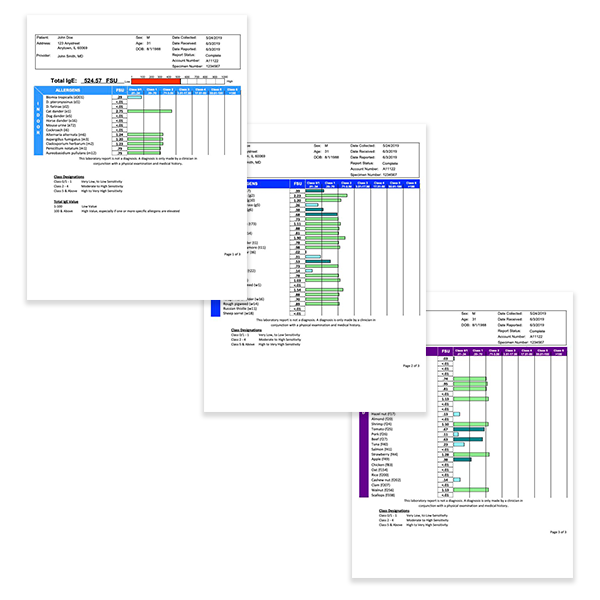Blood Allergy Test
Rapid allergen identification with a simple fingerstick blood test
Identify allergens faster
Diagnosing the cause of common upper respiratory symptoms such as nasal congestion, rhinorrhea, increased secretions, or sneezing can be difficult. This simple in-office fingerstick blood test can simplify it. Patients do not need to stop their medications for the test.
Results from the blood test can:
- Identify specific allergens to reduce exposure
- Rule out allergies and get to the underlying cause
-
Formulate an appropriate treatment plan based on objective evidence
Decide if and when a referral is appropriate


About the allergy blood test and the likelihood of symptoms
When investigating a patient with suspected allergy, having a quantitative IgE test is a very useful tool. When combined with a physical examination and the patient’s clinical history, a treatment plan can be established. The ability to rule out allergy as the cause is also important to avoid unnecessary medication or food avoidance.
The Allergenex test results help identify the patient’s baseline IgE antibody levels. Generally, the higher the IgE antibody the greater the likelihood that symptoms will appear. Still, these concentrations may not correlate with the degree of clinical response or skin testing results when challenged with a specific allergen. Even allergens found at low levels that do not result in symptoms should be followed. These allergens can contribute to the cumulative symptom threshold such as when the patient is exposed to seasonal allergens. Knowing a patient’s specific IgE antibody levels for the substances to which they are sensitive increases the possibility of knowing how the different substances affect their symptoms. The timing and degree of symptoms varies with individuals depending on their levels of IgE antibodies, clinical reactivity, age, gender, travel history, degree of exposure, and family history.
Total IgE
Elevated concentrations of Total IgE may be found in a variety of clinical diseases, including allergic disease, certain primary immunodeficiencies, infections, inflammatory diseases, and malignancies. A normal concentration of Total IgE does not eliminate the possibility of allergic disease.

1. Fill out the form

2. Lancet patient finger

3. Apply blood to card

4. Mail back in provided envelope
Concise reports
Our CLIA certified lab produces quantifiable and graphical results for each profile. Each report contains the Total IgE and a national respiratory profile for 40 inhalant allergens, 28 food allergens, or a combination of 68 food & inhalant allergens, providing excellent positive and negative predictive values. This presentation is efficient for the clinician and educational for the patient

Lab reports, like all forms of testing, are not a diagnosis. A diagnosis of allergic disease can only be made by a qualified health care professional in conjunction with a patient’s exam and clinical history. Test results should be discussed between patient and physician to develop an action plan for guiding treatment options.
“Diagnosing and controlling allergic rhinitis- through avoidance measures, pharmacotherapy or a combination of these- is an important part of an overall allergy management plan.“
— American Academy of Family Physicians
Your staff will love the simplicity.
You will love the profitability.
